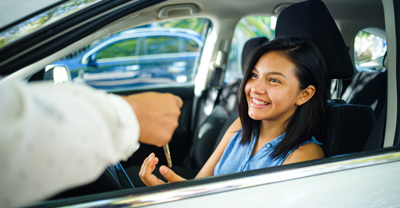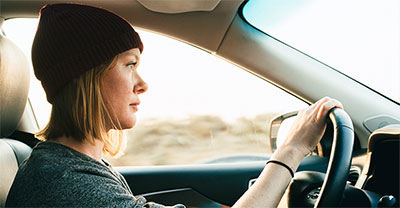Keeping your dog safe during car rides


0 min. read
You buckle up every time you get behind the wheel. But what about your dog? With more people driving alongside their furry copilots, dog car safety is more important than ever. From everyday errands to long-distance travel, a few simple precautions can help protect your pet—and everyone else in the vehicle.

Get a free auto insurance quote today and compare!
Dog car safety: what to consider
Whether you're off to the dog park or heading to the groomer, riding in the car can be an exciting experience for your dog. You're not alone—nearly six in 10 people drove with their dog at least once a month in the past year. Yet surprisingly, only 16% of dog owners use any form of restraint while their dog is in the vehicle.*
While many may feel their dog is calm enough to skip a harness or crate, an unrestrained dog can be dangerous in a crash—capable of generating enough force to harm themselves or other passengers. They can also distract the driver, increasing the risk of an accident. The bottom line? Securing your dog is an easy way to help make every trip safer.
How to safely secure your dog in the car
A variety of methods are available to safely restrain your dog while driving. Some of the best options include placing your furry friend in the back seat or a cargo area with a crash-tested crate, carrier, or harness.
Some pet travel products—like dog seat belts, tethers, and zip lines—are marketed as safety solutions, but may not always secure your dog as effectively as expected. While these products may seem better than nothing, they aren’t always designed to offer crash protection. In some situations, they could become tangled or snagged, posing a risk of injury to your pet—or others in the car.
Although there’s no federal law requiring pet restraints, some state and local laws may apply, especially when it comes to distracted driving. It’s worth checking the rules in your area to stay compliant.
So, what are some ways to help protect your dog on the road? Here are two options that can help reduce risk and improve travel comfort:
A certified crate or carrier
If your dog rides with you regularly, a crash-tested crate or carrier is a great investment. Look for one that gives your dog enough space to lie down and turn around comfortably. Larger dogs usually do best in a secured crate in the cargo area, while smaller dogs may prefer a seatbelt-secured carrier.
Place the crate near the center of the vehicle when possible and secure it using your vehicle’s restraint system or tie-down straps. Adding a non-slip mat underneath can help keep it stable—and protect your interior from any messes or scratches.
A harness made for car rides
Not all harnesses are created for travel, so it’s worth taking a closer look before you buy. Dog car harnesses are different from the ones you use for walks—they’re specially designed to attach to seatbelts and help absorb impact during a sudden stop or crash.
If you go with a harness, look for one that allows your dog to sit upright. That position can help reduce the risk of spine injuries in the event of a quick stop. And if you’re heading out on a longer trip, be sure to build in plenty of breaks so your pup can stretch, sniff, and relax along the way.
Want to be sure you’re choosing the safest option?
The Center for Pet Safety (CPS) maintains a list of certified travel crates, harnesses, and carriers that meet strict crash test criteria. Products that earn CPS Certification are considered Elite Performing Products—designed with both safety and comfort in mind.
How to train your dog for stress-free car rides
Getting used to a harness, crate, or kennel doesn’t always come naturally to dogs. A gentle, gradual introduction can help them feel more secure and at ease. Here are a few simple ways to make the transition smoother:
Start with short, positive sessions outside the vehicle.
Let your dog sniff and explore the crate or harness, and reward them with treats.
Once your dog is comfortable with the equipment, practice having them sit, secured, in the parked car.
Provide them with a favorite toy or blanket to help them feel at home.
Ask a friend to drive your car while you sit with your dog on early rides, offering reassurance and treats.
As your dog becomes more comfortable, gradually increase trip length, spacing out treats to reinforce good behavior.
For longer drives, give your dog extra exercise before you start your trip. Also, feed them a few hours in advance so they have time to relieve themselves.
Extra tips for traveling safely with your pet
Whether you’re heading across town or across the country, these extra tips can help you keep your dog safe, comfortable, and happy on the road:
Pack the essentials: Include food, water, waste bags, medications, and vaccination documents if needed.
Schedule regular breaks: Stop often for exercise and potty time to help keep your dog relaxed and healthy.
Feed only when parked: This can help reduce the risk of choking or motion sickness.
Use a collar with updated ID tags: Or have your dog microchipped in case they get lost.
Add a temporary ID tag: For longer trips, include your destination address.
Look into pet insurance: It can help cover emergency care while you’re on the road.
What not to do when driving with your dog
Sometimes it’s easier to think about dog car safety in terms of what to avoid. Remembering the risks associated with having your dog in the car could help you prevent an accident, injury, or even a fine.
Skip the front seat: Letting your dog ride unrestrained in the front seat puts them—and you—at risk in a crash. Airbags can also cause serious injuries to pets.
Never leave your dog alone in the car: Even on mild days, temperatures inside a vehicle can rise quickly and become life-threatening. Leaving a pet unattended may also lead to legal penalties in some states.
Keep heads and paws inside the vehicle: While dogs may love the breeze, open windows expose them to flying debris and the risk of jumping out to chase something.
Don’t let your dog ride unrestrained in a truck bed: It’s unsafe and often illegal. Some states, like California, require dogs in truck beds to be in a crate or securely tethered.
Help protect every passenger—even the furry ones

Keeping your dog safe in the car is about more than avoiding fines—it’s about making the journey safer for everyone on board. With a little planning and the right gear, you and your pup can enjoy the ride with confidence. And while you focus on your dog's comfort, Dairyland®—a brand of the Sentry Insurance Group—can help protect the rest of the trip with flexible, affordable auto coverage for you.

Request a free auto insurance quote today!
*All product names, logos, brands, and trademarks are property of their respective owners. All company, product, and service names are for identification purposes only. Use of any of the foregoing does not imply endorsement.
The general information in this blog is for informational or entertainment purposes only. View our blog disclaimer.










